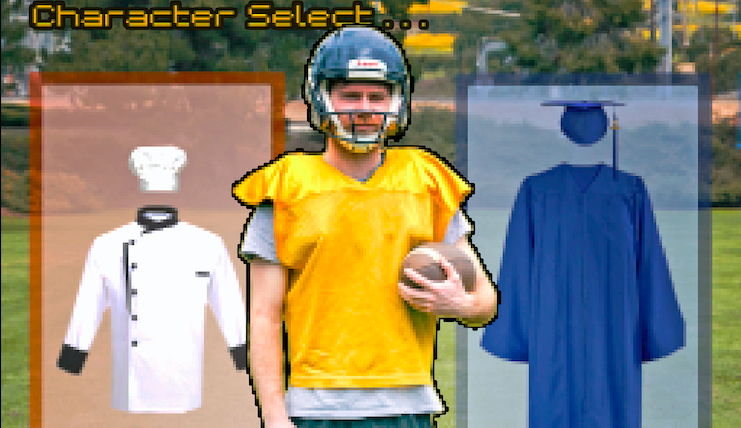Branden Rankins began his commute to school at 5 a.m. from San Bernardino to Fullerton College in order to make it on time for morning weights. Practices would end around 5:30 p.m., but his drive home sometimes began hours after practice to avoid sitting in traffic. Waiting for traffic to die down seems as if it would cost the same amount of time as just sitting in the traffic, but Rankins’ old Saturn would turn off if it was idle for too long. The wait isn’t as bad as having the brakes stop working and having to leave the car on campus for a week until he could pay for the expensive tow back home. For Rankins, the biggest part of his struggle was his transportation.
Athletes find themselves at junior colleges for a variety of reasons. Some are looking to get more opportunities after high school, some have the talent but not the grades, and others are looking for a second opportunity after the first school they went to didn’t work out. Regardless of the situation, it is everyone’s last chance to play the sport they love. But that comes at a cost.
Without access to the levels of funding that university athletes have, the life of a junior college athlete has become known as the Juco struggle.
At four-year universities, players are allowed to receive full scholarships including tuition, fees, housing, and meal plans. With the new name, image, and likeliness rules, student-athletes are now able to receive financial compensation. Last year’s Heisman Award winner, Bryce Young was the NCAA’s highest-paid athlete garnering $3.2 million last season while at the University of Alabama.
Junior colleges in California belong to the California Community College Athletic Association, which prohibits students from receiving athletic scholarships. Their other organization is the National Junior College Athletic Association which has multiple divisions, just like the NCAA, and its member schools can offer full-ride scholarships. The schools in the top division of the NJCAA are able to provide up to 85 football scholarships depending on the budget of the school.
With limited or no options for athletic scholarships, student-athletes in California must rely on financial aid to combat the costs of tuition, fees, and supplies. Students can sign up for FAFSA and have access to up to almost $7,000 in financial aid. There are multiple grants students have access to such as the California College Promise Grant, Cal Grant, and the Pell Grant. First time college students have access to free tuition through the California Promise Program which provides two years of free tuition. These grants differ depending on the students’ situation, income, and GPA. Often, financial aid will be able to cover the cost of tuition, fees, and supplies but student-athletes still need to pay for the cost of living.
Athletes will travel from all over the country to attend and play at Jucos in California due to the high level of competition and ability to generate offers. Fullerton College has one of the premier teams not only in the state but in the entire country after winning back-to-back national championships in 2016 and 2017. According to Coach Phil Austin, 95% of sophomore football players leave with a scholarship.
Coach Austin went through the system himself attending Pasadena City College before playing football at the University of Hawaii. He sees Juco as an opportunity for many of these players. They have to overcome different situations. Players have to work if they do not have support from their families, others need to work to support their families, some care for children of their own.
“There’s a lot of hurdles and we have to find a path for each student to help them reach their ultimate goal. A lot of times actually, I think we’re saving lives,” says Austin.
The goal for Austin is to get these kids out of Juco and give them a chance at life while using football to pay for their schooling. With a degree, these players will be able to work careers with upward mobility. Austin and the rest of the coaching staff do their best to help guide players down the path that is best for them. About half of the incoming freshmen coming from out of state are recommended to gray shirt, which means the player will not be a full-time student and the year will not count towards their eligibility while they train and practice with the team. Gray-shirting will save them money on tuition while giving them a year to establish residency to receive in-state tuition. Coaches do their best to help players utilize financial aid to the best of their ability.
James Griffin, formerly a receiver coach and recruiter at Fullerton College, says that players come to California because of the competition. California not only has high-level teams, but the sheer amount of Juco football programs outweighs every other state.
Griffin does not like the term “Juco struggle,” and says that it is only a struggle for the people who don’t want to work hard. “If you like to work, it’s not a struggle. The ones struggling are the ones living in downtown LA in a box.” At the end of the day, it is a life decision and the players chose to come to California to play and go through this.
Branden Rankins was a top running back in the state coming out of Aquinas High School in San Bernardino where he was a walk-on at the University of Utah. Branden did not receive a scholarship to play at Utah so he left and bounced back to Fullerton College because he knew he could earn a scholarship after going to Juco. He made the decision because he disagreed with paying so much for general education classes at a university and chose to save on tuition.
To Rankins, Juco was a struggle, but he considered it a necessary one. In his first year at Fullerton, he had completed around 50-60 credits because he simply had nothing else to do. He had to earn his AA degree as soon as possible so he would be able to transfer back to a four-year university when the opportunity presented itself.
While playing at Fullerton, Rankins had trouble sleeping. He was so focused on his future that it caused him to be anxious. “I just wanted to do more than where I was at, I couldn’t really focus on the now,” Rankins says.
“If you’re a junior college athlete, let me say this, congratulations because you’re determined. You’re very determined to play more football or to go to the next level. And if you’re going through this grind, you’ve gotta realize, it is going to be mentally and physically taxing on you.”
Players coming from other states will have to pay rent on top of their cost of living. Out-of-state athletes often have to work part-time and sometimes even full-time in order to cover the cost of living in addition to being full-time students and athletes.
Malik Winston, running back at Fullerton College, says that he started working almost immediately after arriving in California. Winston is from Mount Horeb, Wisconsin, and came to Fullerton after taking a gap year during the Covid-19 season. He started out playing for Northern Illinois University but entered the NCAA transfer portal during the pandemic and didn’t get picked up by another school.
“Coach Austin had a security job set up for me within a few days of getting to Cali and I would work those security jobs and referee flag football,” Winston says.
Winston also said he took advantage of the free meals and food bank on campus as much as he could, but that it was definitely necessary to sustain some sort of income. His change of scenery from Wisconsin to California was not the most difficult to adjust to but it was hard at times not having family nearby for support.
When Winston talks about what Juco athletes go through, he says that the struggle is worth it whether you make it out or not. Learning to provide for yourself and manage your time between class, practice, and work helps you grow as a person.
Casey Eyman was a former Fullerton College football player who attended Fullerton in 2013 and 2014. He saw the Juco struggle firsthand and knew he wanted to work in a position where he would be able to help these student-athletes. Casey became a life coach at Fullerton College in 2019 and is now in his first year of being an academic counselor.
Eyman looked back on his time as a Juco athlete and described it as a juggling act. It was also difficult dealing with the slow process of junior college.
“It was manageable for me because luckily I had my parents’ house to go back to and that support system. But as far as like, comparing yourself to others, you may have friends go, or see them progress quicker than you while you’re still stuck. It took me three to four years to get out of junior college, grade-wise, eligibility-wise, and recruitment-wise.”
Eyman started his Juco career at Golden West College where he gray-shirted and red-shirted for two seasons before he transferred to Fullerton College. A gray shirt will take less than 12 units in their first year in order to get an extra year of eligibility on your clock. A red shirt is similar as it saves a year of eligibility, but the athlete must be a full-time student. Both red and gray shirts may train with the team but can not play in the games.
“I was really trying to develop that skill on top of, you know, completing all my classes, full-time schedule, having to work in my off time. So it was always a constant juggling act of those three things. But always wanting to make sure, I gave my energy and attention and kept football as the main focus.”
Eyman worked a variety of jobs while being a student-athlete including working at a shoe store and being a busser at different restaurants and bars. He said he wanted to work with student-athletes to help guide them in the right direction.
Jacob Jones played on the Fullerton College football team from 2017 to 2019 and received a scholarship to Idaho State University. Jones has played at multiple collegiate levels and has played with players from all over the US and he says that players who made it through Juco really know about going through the struggle.
Jones was a walk-on at Northern Arizona University. As a walk-on, he was on the team but not receiving an athletic scholarship. Jones made the decision to leave NAU because he believed he could earn an athletic scholarship at another university. Jones chose Fullerton College where he would be able to live at his parents’ house in La Habra, only one city away.
While he did not have to pay rent, he faced his own struggles on his journey. After his freshman season, Jones sustained a serious injury that put his future into question. After a solid freshman season, he tore his calf before his sophomore season.
“So I was out the entire year on a calf injury, I tore my calf, half of it completely tore off. And so that was definitely tough, mentally because you’re like, Okay, I’m hurt. I’m not playing football. You question if I can even do this again. And if I do get better, how fast will I get better, you know, you have all these things running through your head. I almost couldn’t go to division one because of this injury and it set me back.”
Athletes will go this route for a number of different reasons. Some do not have the grades to get into a four-year university. Others may have not received enough exposure from higher-level schools out of high school. A few athletes will bounce back for a variety of reasons including differences in opinions with coaching, choosing to be walk-ons to earn a scholarship, or simply needing a fresh start.
“There’s a lot of teammates that didn’t have a lot. They were sleeping on the floor, sleeping on couches, going from house to house, and trying to find something to eat. Going off of EBT and food stamps. I remember teammates asking me if I could take them to Walmart because they accepted EBT. And we would go, and they would get their groceries because that’s the only way they could pay for it because they didn’t have anything.”
Jones saw the hardships some of his teammates went to and used that as fuel to succeed. He stressed the importance of the company you keep and keeping your teammates in check.
The struggle is not for everyone, but almost everyone who goes through Juco knows exactly how these athletes feel.
“I’d rather struggle and get somewhere than not struggle and just sit and be comfortable, not elevating my life. If you’re struggling, I mean, at least you’re fighting through it. If you’re not struggling, then you give up,“ says Branden Rankins.



